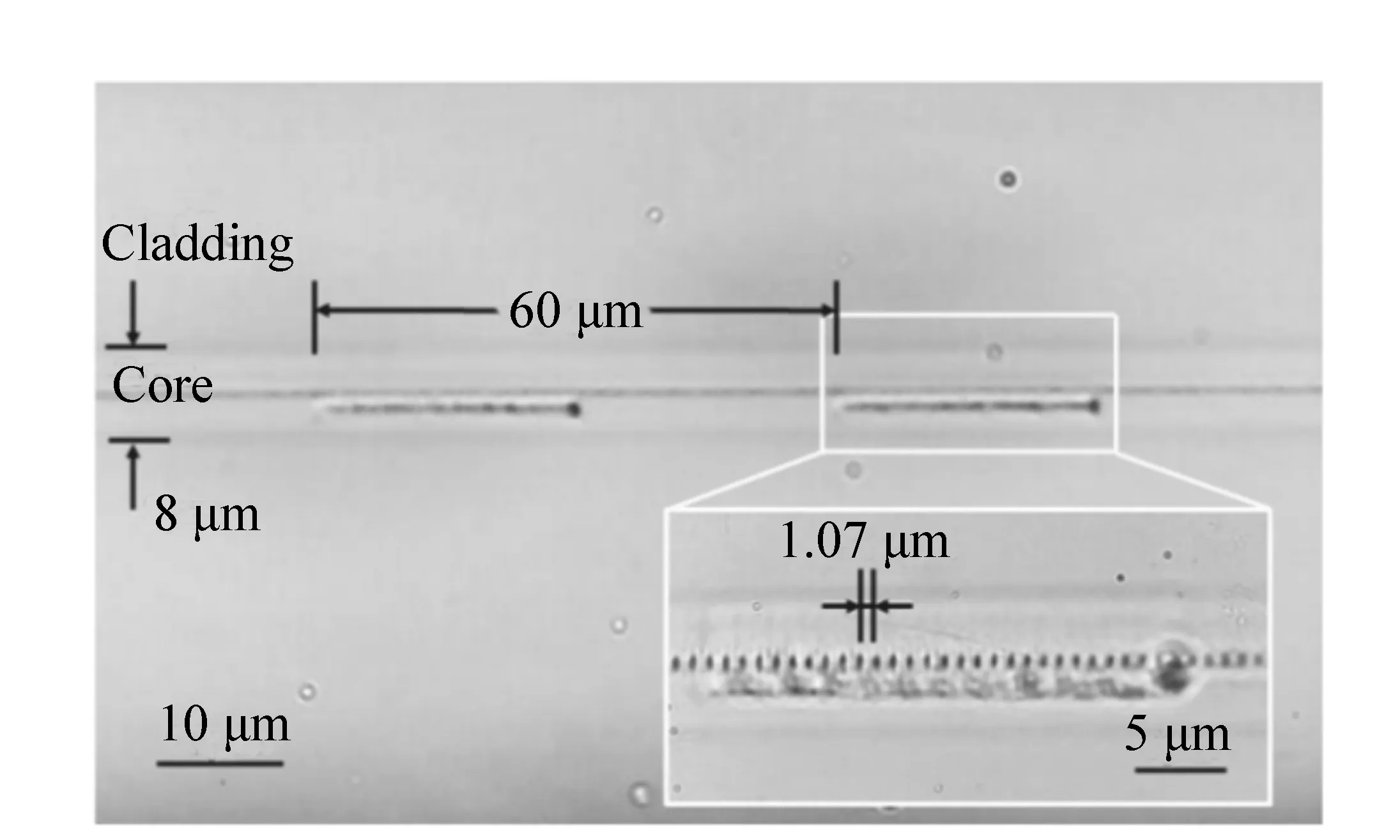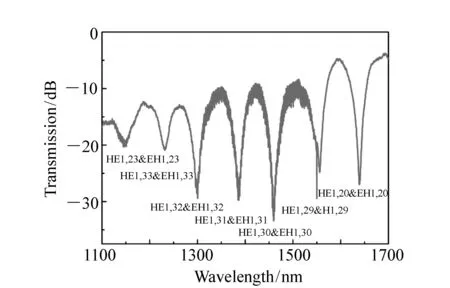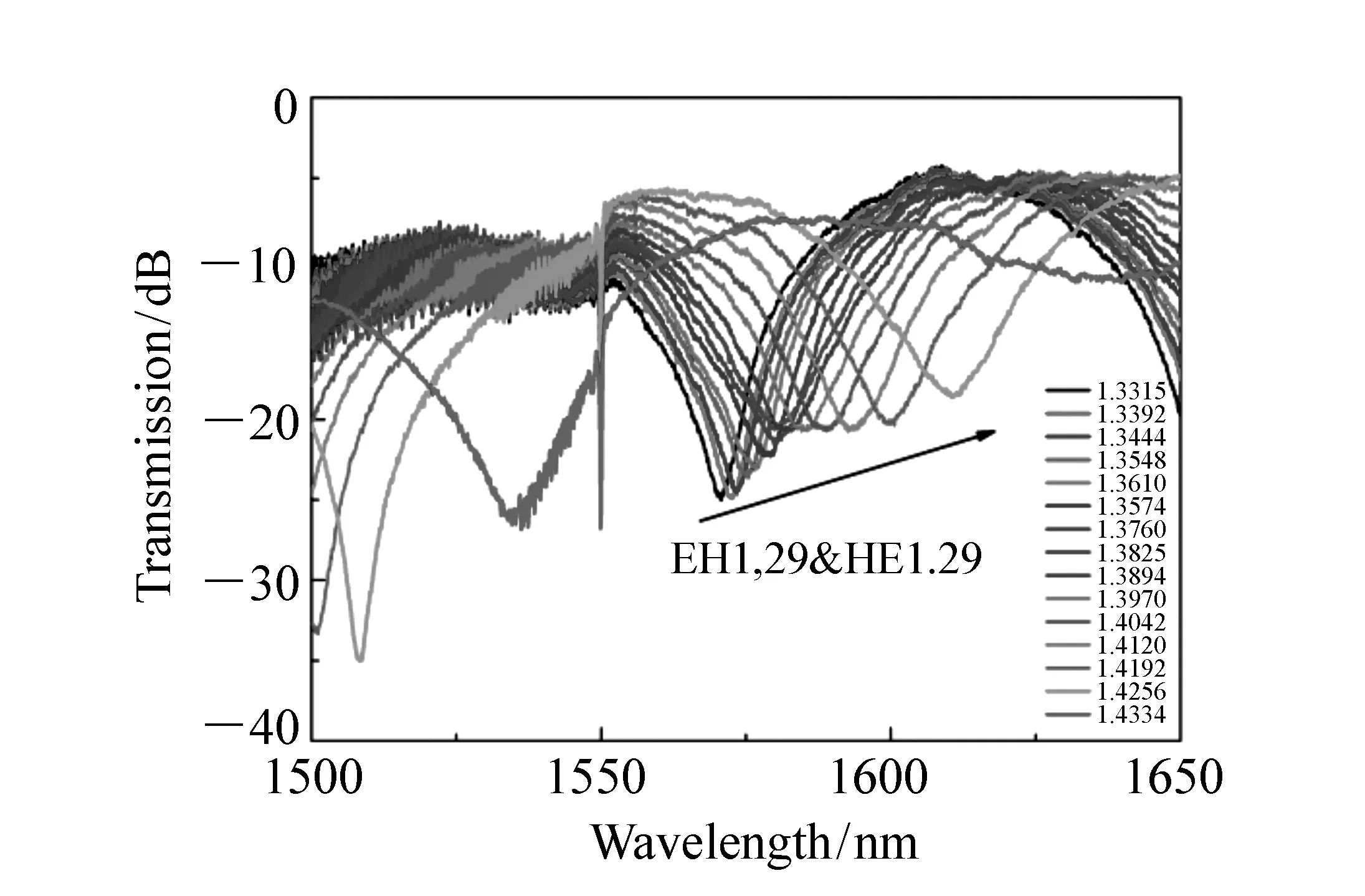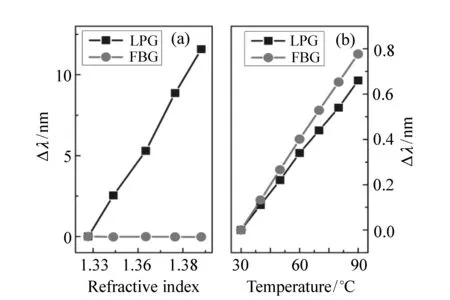Integrated optical sensor based on a FBG in parallel with a LPG
LIANG Ju-fa, JING Shi-mei, MENG Ai-hua, CHEN Chao, LIU Yun, YU Yong-sen*
( 1.State Key Laboratory on Integrated Optoelectronics,College of ElectronicScience and Engineering,Jilin University, Changchun 130012,China;2.State Key Laboratory of Luminescence and Application,Changchun Institute of Optics,Fine Mechanics and Physics,Chinese Academy of Sciences,Changchun 130033,China)*Corresponding author, Email:yuys@jlu.edu.cn
Integrated optical sensor based on a FBG in parallel with a LPG
LIANG Ju-fa1, JING Shi-mei1, MENG Ai-hua1, CHEN Chao2, LIU Yun2, YU Yong-sen1*
( 1.State Key Laboratory on Integrated Optoelectronics,College of ElectronicScienceandEngineering,JilinUniversity,Changchun130012,China;2.StateKeyLaboratoryofLuminescenceandApplication,ChangchunInstituteofOptics,FineMechanicsandPhysics,ChineseAcademyofSciences,Changchun130033,China)*Correspondingauthor,Email:yuys@jlu.edu.cn
In order to improve the performance of the fiber optic sensors and further reduce the size of them, a new integrated optical sensor based on a fiber Bragg grating(FBG) in parallel with a long-period grating(LPG) in a single mode fiber is reported in this paper. The FBG and the LPG are fabricated by femtosecond laser using direct inscription process. The variations of temperature and refractive index will cause the variations of resonant wavelengths of FBG and LPG. The experimental results show that the refractive index sensitivities of the FBG and the LPG respectively are 0 nm/RIU and 196.46 nm/RIU, and the temperature sensitivities of them are 12.98 pm/℃ and 10.93 pm/℃ respectively. Therefore, this sensor can be used for measuring temperature and refractive index simultaneously according to the dual parameters sensing matrix.
integrated optical sensor;fiber Bragg grating(FBG);long-period grating(LPG);femtosecond laser
1 Introduction
Since the first fiber grating was fabricated by the standing wave method in 1978[1], the fiber grating has attracted considerable attention for applications in telecommunications and fiber sensor systems[2-8]. In-fiber gratings, including fiber Bragg gratings(FBGs) and long-period gratings(LPGs), have been used to measure various physical parameters. In the FBGs the forward-propagating core mode is coupled to the backward-propagating core mode, while in the LPGs the core mode is coupled to the cladding mode with its evanescent fields extending to the surrounding environment. As a result, FBGs are sensitive to the temperature and strain, while LPGs are sensitive to the surrounding refractive-index(SRI) besides temperature and strain[6-8]. Because FBGs and LPGs have different optical properties, there is a great interest in combination of the FBG and the LPG as a novel sensor. Recently, Ming Hanetal. have demonstrated an optical fiber refractometer based on a cladding-mode Bragg grating, which consists of a LPG followed by a FBG[9]. Similarly, Ming Yue-Fu has suggested that one may achieve measurement of SRI using a concatenation of a FBG and a LPG[10]. To our knowledge, most previous publication have used concatenation of the FBG and the LPG to measure physical parameters. However, the size of these sensors based on concatenation of the FBG and the LPG(2-gratings-length) are larger than the single LPG or FBG, thus, it is not convenient to utilize them in the integrated optical system. Femtosecond laser direct inscription technology can be used to inscribe vavious sizes of gratings in any position of the optical fiber, and the RI modulation intensity of gratings can be controled through the regulation of the laser power. Thus, the difficulty of the optical integration in fiber is greatly reduced with this technology.
In this article, we propose a simple and novel integrated optical sensor based on a FBG in parallel with a LPG by femtosecond direct inscription technology. The sensor consists of a FBG and a LPG, in which the FBG is inscribed in the center position of the fiber core, while LPG is in the off-center position. Thus, this integration of the FBG and the LPG is much smaller(1-grating-length). The FBG and the LPG in this sensor have maintained their respective optical properties: the FBG is sensitive to temperature, but not to SRI, while the LPG is sensitive to temperature and SRI. Therefore, the working principle of the sensor is that the changes of temperature and SRI result in the different wavelength changes of the FBG's resonant peak and the LPG′s. According to the dual parameters matrix, we can use these different wavelength changes to measure temperature and refractive index simultaneously.
2 Experiments
The FBG and the LPG in this integrated optical sensor were inscribed in the SMF-28e by femtosecond direct inscription process. The schematic diagram of the sensor is shown in Fig.1. In our experiments, a Ti:sapphire regenerative amplifier laser system(Spectra Physics) operating at 800 nm was adopted. The laser beam was focused into the fiber core via an oil-immersed 60 Olympus objective(N.A.,1.42). We mounted the fiber on a computer-controlled three-axis translation stage with a motion spatial resolution of 20 nm. The transmission spectra of the sensor were monitored by a broadband light source(Superk Compact, NKT Photonics) and an optical spectrum analyzer(OSA, AQ6370D, Yokogawa) with a resolution of 0.02 nm.

Fig.1 Schematic diagram of the integrated optical sensor

Fig.2 Side-view microscope image of RI modulation region of the FBG and the LPG in the fiber core(the inset is the enlarged view of the grating structure)

Fig.3 Transmission spectra of the FBG and the FBG in parallel with the LPG in the oil(the inset is the details of the Bragg resonant peak)

Fig.4 Transmission spectrum of the integrated optical sensor in the air and the high order cladding modes corresponding to the loss peaks of the LPG
First of all, the laser frequency and the laser power were respectively set at 100 Hz and 70 nJ/pulse, and the translation speed of the fiber was set at 0.107 1 mm/s. Using point-by-point(PbP) direct inscription process[11], a 2.4-mm-long FBG was written in the center of the fiber core, and the period of which was 1.07 μm. Thus it is the second order FBG with a Bragg wavelength around 1 550 nm. Then we set the laser frequency at 1 000 Hz and the translation speed at 0.01 mm/s, and the laser power was maintained at 70 nJ/pulse to write the LPG. The 2.4-mm-long LPG was written at the position deviated from the center of the core of about 1.8 μm, which was in parallel with the FBG as shown in Fig.2. The period of the LPG is 60 μm. We can observe that the fabrication process of LPG did not damage the RI modulation region of the FBG. In Fig.3, we can note that in the fabrication process, the inscription of the LPG did not vary the wavelength of the FBG resonant peak, however, just reduced the overall power of the transmission. Fig.4 shows the experimental transmission spectrum of the sensor in the air. We can observe that there are seven loss peaks of the LPG and one Bragg resonant peak from 1 100 nm to 1 700 nm. The reason why we inscribe this short period compact LPG is that it has a high surrounding refractive-index(SRI) sensitivity[12]. According to the previous report[12], we can infer that the seven loss peaks of the LPG correspond to seven different cladding modes(HE1, 20 and HE1, 23 correspond to the first order diffraction, and HE1, 29-HE1, 33 correspond to the second-order diffraction). Because of the high localization of the PbP FBG, there are some cladding mode resonances in the shortwave direction of Bragg resonant peak, but it does not affect the performance of the sensor. In the FBG the forward-propagating core mode is coupled to the backward-propagating core mode, while in the LPG the core mode is coupled to the cladding mode. In this integrated optical sensor, the FBG and the LPG maintain their respective properties.
3 Sensing characteristics
After the fabrication process, we studied the sensing characteristics of the integrated optical sensor. The loss peak around 1 555 nm corresponding to the HE1, 29 mode at the second-order diffraction and the Bragg resonant peak at 1 550 nm were chosen for sensing applications. We first measured the SRI sensitivity of the sensor. The fiber sensor was placed into a glass slot and kept it straight. After the sensor was fixed, we injected RI solutions into the glass slot so that the sensor was totally immersed. After the spectrum was recorded, the sensor were then cleaned using ethanol and deionized water. The procedure was repeated to measure the other RI solutions(different volume ratio of glycerin and water mixed solutions). The RI of the solution was measured by the Abbe refractometer at room temperature. As shown in Fig.5, in the RI range from 1.33 to 1.44, the wavelength of the resonant peak of the FBG almost has no change, while the loss peak of the LPG exhibits an obvious redshift. From the function of the loss peak wavelength shift and the SRI, we can achieve the RI sensitivity of 196.46 nm/RIU and the linearity of 0.994 8, as shown in Fig.6(a).

Fig.5 Shifts of the loss peak wavelength of the sensor with different RI solutions

Fig.6 (a)Wavelengths of the Bragg resonant peak and the LPG loss peak change with the SRI, (b)wavelengths of the Bragg resonant peak and the LPG loss peak change with temperature
The temperature sensitivity of the sensor was also measured. The sensor was placed in a digitally controlled furnace. Later, the furnace was heated up from 30 ℃ to 90 ℃ with the increment of 10 ℃ for one step. After one-step increment, we kept the sensor at that temperature for 20 minutes and recorded the transmission spectrum at each step. We can observe that the wavelengths of the chosen loss peak and the Bragg resonant peak have redshift with the increasement of temperature(as shown in Fig.6(b) ). In this temperature range, we analysis the function of the FBG′s and the LPG′s resonant wavelengths and the temperature, and we obtain that the temperature sensitivities of the FBG and the LPG are 12.98 pm/℃ and 10.93 pm/℃, respectively, and their linearities are 0.999 6 and 0.999 3. We can observe that the temperature sensitivity of the LPG is very small, even smaller than the FBG′s. The reason is that the LPG in this sensor was writen in the off-center position and the period of the LPG is just 60 μm, which is much smaller than the general LPGs(hundreds of micrometers). When the temperature changes, the changes of effective indice and the period of the LPG are smaller than the other LPGs. Therefore, this LPG has such small temperature sensitivity.
As mentioned above, the sensitivities of the Bragg resonant peak to temperature and SRI are different with the sensitivities of the loss peak of LPG, so this integrated optical sensor can be used to measure temperature and SRI simultaneously. The relationship between these variables can be expressed in the form of matrix:
(1)
whereA1 andA2 are the SRI sensitivity and temperature sensitivity for the Bragg resonant peak respectively, whileB1 andB2 are the sensitivities for the loss peak of LPG. Substituting the values obtained from experiments into the matrix, the final expression can be written as:
(2)
4 Conclusion
In conclusion, we have fabricated a small size and novel integrated optical sensor based on a FBG in parallel with a LPG in a common SMF using fs-laser direct inscription process. The length of this integrated optical sensor is 2.4 mm. The RI modulation of the gratings can be controlled through changing laser pulses power, laser frequency and the translation speed of the fiber. In addition, we have demonstrated the measurement for temperature and the SRI by this sensor and obtained the sensing matrix to achieve dual parameters sensing.
[1]HILL K O,FUJII Y,JOHNSON D C,etal.. Photosensitivity on optical fiber waveguides: application to reflection filter fabrication[J].Appl.Phys.Lett.,1978,32(10):647-649.
[2]XU M G,REEKIE L CHOW Y T,etal.. Optical in-fiber grating high-pressure sensor[J].Electron.Lett.,1993,29(4):398-399.
[3]PATRICK H J,WILLIAMS G M,KERSEY A D,etal. Hybrid fiber Bragg grating/long-period fiber grating sensor for strain/temperature discrimination[J].Photon.Technol.Lett.,1996,8(9):1223-1225.678.
[4]WOLFBELS O S. Fiber-optic chemical sensors and biosensor[J].Anal.Chem.,2002,74(12):2663-2678.
[5]LIANG W,HUANG Y,XU Y,etal.. Highly sensitive fiber Bragg grating refractive index sensors[J].Appl.Phys.Lett.,2005,86(15):151122-1-151122-3.
[6]XU G Q,XIONG D Y. Application of fiber Bragg grating sensing technology in engineering[J].ChineseOptics,2013,6(3): 306-317.
[7]SUN X,WANG Q M,ZHU M,etal.. Application of optical fiber Bragg grating strain gauge to cable force monitoring of FAST[J].OpticsandPrecisionEngineering,2015,23(4):919-925.
[8]SAI Y Z,JIANG M S,SUI Q M,etal.. Acoustic emission location based on FBG array and MVDR algorithm[J].OpticsandPrecisionEngineering,2015,23(11):3012-3017.
[9]BHATIA V,VENGSARKAR A M. Optical fiber long-period gratin sensors[J].Opt.Lett.,1996,21(9):692-694.
[10]BHATIA V,CAMPBELL R O,VENGSARKAR A M. Simultaneous strain and temperature measurement with long-period gratings[J].Opt.Lett.,1997,22(9):48-650.
[11]YE C C,JAMES S W,TATAM R P. Simultaneous temperature and bend sesing with long-period fiber gratings[J].Opt.Lett.,2000,25(14):1007-1009.
[12]HAN M,GUO F,LU Y. Optical fiber refractometer based on cladding-mode Bragg grating[J].Opt.Lett.,2010,35(3):399-401.
[13]FU M Y. Refractive index sensing based on the refractivity of the backward cladding-core mode coupling in a concatenated fiber Bragg grating and a long period grating[J].SensorJournal,2012,12(5):1415-1420.
[14]MALO B,HILL K O,BILODEAU F,etal.. Point-by-point fabrication of micro-Bragg gratings in photosensitive fiber using single excimer pulse refractive index modification techniques[J].Electron.Lett,,1993,29(18):1668-1669.
[15]GUO J C,YU Y S,ZHANG X L,etal.. Compact long-period fiber gratings with resonance at second-order diffraction[J].Photon.Technol.Lett.,2012,24(16):1393-1395.
Authors′ biographies:
2016-03-03;
2016-03-23
吉林省科技发展计划资助项目(No.20150520089JH);长春市科技局重大科技攻关专项资助项目 (No.13KG22)
2095-1531(2016)03-0329-06
基于光纤布拉格光栅与长周期光栅并联的集成光学传感器
梁居发1,敬世美1,孟爱华1,陈超2,刘云2,于永森1*
(1.吉林大学 电子科学与工程学院 集成光电子国家重点实验室,吉林 长春 130012;2. 中国科学院 长春光学精密机械与物理研究所 发光学及应用国家重点实验室,吉林 长春 130033)
为了提高光纤传感器的性能和进一步缩小传感器的尺寸,通过实验制备出一种基于光纤布拉格光栅(FBG)与长周期光栅(LPG)并联的新型集成光学传感器。该传感器中的FBG和LPG是利用飞秒激光直写技术直接在普通单模光纤中刻写的。FBG和LPG是并联关系,因此很大程度地缩小了传感器的长度。外界的温度和折射率的变化会引起FBG和LPG的谐振峰波长位置发生变化,据此对该集成传感器进行温度和折射率测量。实验结果表明:FBG谐振峰对折射率和温度的灵敏度分别为0 nm/RIU和12.98 pm/℃,而LPG在1 555 nm附近谐振峰对折射率和温度的灵敏度为196.46 nm/RIU和10.93 pm/℃。因此,根据双参数传感矩阵,该传感器可以对温度和外界折射率进行同时传感。
集成光学传感器;光学布拉格光栅(FBG);长周期光栅(LPG);飞秒激光
TN253
A

LIANG Ju-fa(1990—), male, born in Yunfu, Guangdong Province. He received his bachelor's degree in College of Electronic Science and Engineering, Jilin University in 2013. Now he is a master student in College of Electronic Science and Engineering, Jilin University. His research interest is optical fiber sensors. E-mail:souldean@163.com

YU Yong-sen(1974—), male, born in Changchun, Jilin Province. He received his doctor's degree in College of Electronic Science and Engineering, Jilin University in 2005. And now he is a professor in College of Electronic Science and Engineering, Jilin University. His research interest is optical fiber gratings and optical fiber sensors. E-mail:yuys@jlu.edu.cn
10.3788/CO.20160903.0329
Supported by Jilin Provincial Science and Technology Development Plan Project(No.20150520089JH), Changchun City Science and Technology Bureau Major Scientific Research Project(No.13KG22)

